- India
- International
Taking the Mahatma to Venice
After eight years, India returns to the prestigious Venice Biennale with an official pavilion. Eight modern and contemporary artists examine the legacy of Mahatma Gandhi, 150 years after his birth.
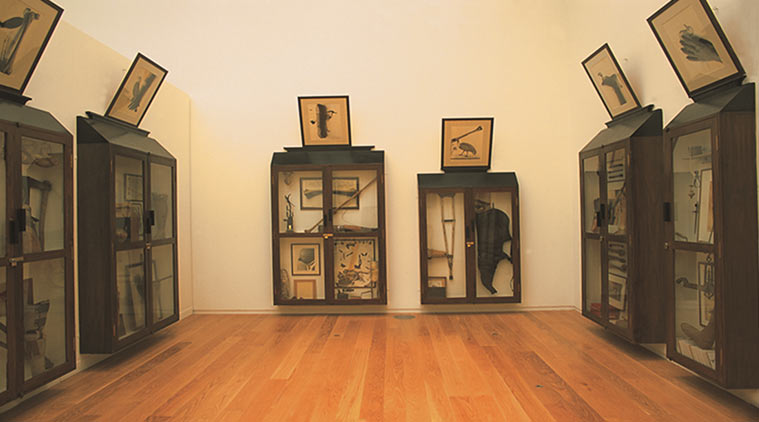 The work, which Dodiya has been deliberating on since 1997, was created in the aftermath of the Godhra riots.
The work, which Dodiya has been deliberating on since 1997, was created in the aftermath of the Godhra riots.
Atul Dodiya
Deeply inspired by Mahatma Gandhi, Atul Dodiya has often turned to the leader and his philosophy in his work. Showing at the biennale is the celebrated 2002 installation Broken Branches. “The conflict between communities has been rejected by any sensitive person and in that context Gandhian philosophy keeps coming back to us — ‘An eye for an eye will make the whole world blind’,” says Dodiya, 60.
The work, which Dodiya has been deliberating on since 1997, was created in the aftermath of the Godhra riots, when he visited Gandhi’s birthplace, Kirti Mandir in Porbandar. On that visit, he noticed how Gandhi’s belongings and photographs had been kept in cabinets with slanted tops to keep the birds away.
Dodiya meticulously replicated the design but placed an image of a bird on top of each of the eight vitrines. “These birds are a metaphor for our souls, which are trying to find purity and gentleness in times of violence,” says the Mumbai-based artist.
Inside the wooden cabinets is an assemblage through which Dodiya depicts communal suffering and emphasises how the personal and the political are intertwined. On view are prosthetic limbs, replicas of human bones, hand-painted photographs, construction tools and “various found objects that reject vehemently the very notion of violence, intolerance and hate”. “I feel it’s an apt theme for India to present to the world and its viewers — Gandhi and his philosophy of love and non-violence still matters to Indian artists in today’s intolerant and violent world,” says Dodiya.
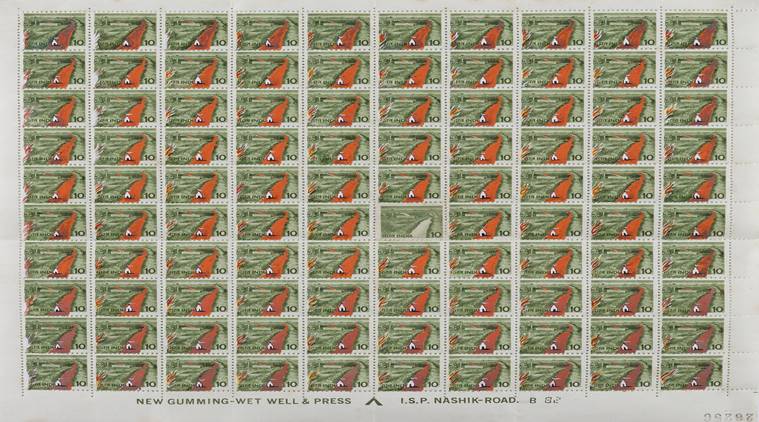 Ashim Purkayastha reproduces revenue stamps and other government papers with Gandhi’s portraits but without the spectacles.
Ashim Purkayastha reproduces revenue stamps and other government papers with Gandhi’s portraits but without the spectacles.
Ashim Purkayastha
Through his work at the Venice Biennale, Ashim Purkayastha asserts that everyone has the right to question Gandhian ideals. “It should not be a prerogative of a few intellectuals to be able to discuss the relevance of his principles,” says the Delhi-based artist. Several of his works are reimaginings on revenue and postage stamps.

In the series Gandhi/Man Without Specs, he reproduces revenue stamps and other government papers with Gandhi’s portraits but without the spectacles — symbolic of his lack of foresight in some matters. In another work, Sindoor and Holy Water, he has a water pump spouting blood and not water and the original white pathway in the field (he alters in the stamps) is filled with saffron and a temple at the end of the path, referring to “saffronisation”. The Aam Aadmi series is a set of 12 drawings of people Purkayastha encountered on the streets. “I asked them to pose in a quirky manner,” he says.
While Purkayastha, 52, has depicted the indifference of successive governments at the Centre towards Northeast in several of his past works, at the biennale, his installation Shelter portrays the predicament of migrants and the changing idea of home. The three-dimensional installation, accompanied by a canvas, is made of bricks, stones and broken pieces of marbles that Purkayastha has been collecting from across Delhi since 2015. He wraps them with rice paper and paints them with a landmark or the name of the street from where they were picked. “It gives them an identity of sorts,” says Purkayastha. Among others, there is the statue of Hanuman near Jhandewalan, the iconic Gole Market and Govindpuri, where Purkayastha stayed in a one-room apartment when he first moved to Delhi in 1997 after completing his Master’s of fine arts from Santiniketan. “I felt that for my voice to be heard I should be in the national capital,” he says.
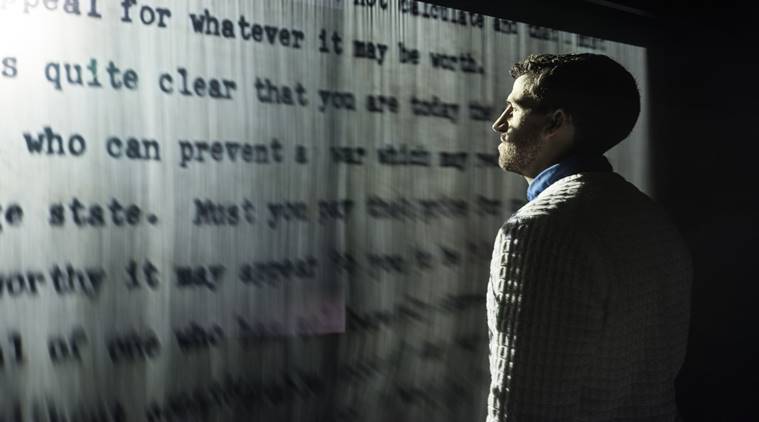 The viewers enter a dark room filled with fog and encounter the words written by Gandhi.
The viewers enter a dark room filled with fog and encounter the words written by Gandhi.
Jitish Kallat
At a time when the world is plagued with violence, Jitish Kallat, with his work Covering Letter (2012), goes back into history to revisit a letter written by Mahatma Gandhi to Adolf Hitler in July 1939, weeks before the German invasion of Poland, marking the beginning of World War II. Ruminating over the bloodshed a war would lead to, the letter has Gandhi appealing to Hitler for peace and urging him to resist “reducing humanity to a savage state”.
Held back by the British government then (India was still under the colonial rule) and now exhibited at the Gandhi museum in Mumbai, the letter had been on Kallat’s mind since he first saw it in 2009. “It reads like a thoughtfully composed haiku with its intent tightly held within a wrap of ambivalence. There is a sense of perplexity in the way that Gandhi words his address; as the principal proponent of peace from a historical moment, he greets Hitler, one of the most violent individuals of that era, as a friend,” says Kallat, 44.
The Mumbai-based artist reproduces the plea for peace with a video projection on a curtain of mist, where the viewers enter a dark room filled with fog and encounter the words written by Gandhi. “The viewer is at the centre of Covering Letter, and each visitor brings in different personal, social and historical experience to the work, in a way altering its meaning,” says Kallat. Known to engage with history through the words of prominent figures, with this work, Kallat also discusses the possibilities of peace in contemporary times.
He notes that like many of Gandhi’s gestures and his life experiments, “this piece of correspondence seems like an open letter destined to travel beyond its delivery date and intended recipient — a letter written to anyone, anytime, anywhere.”
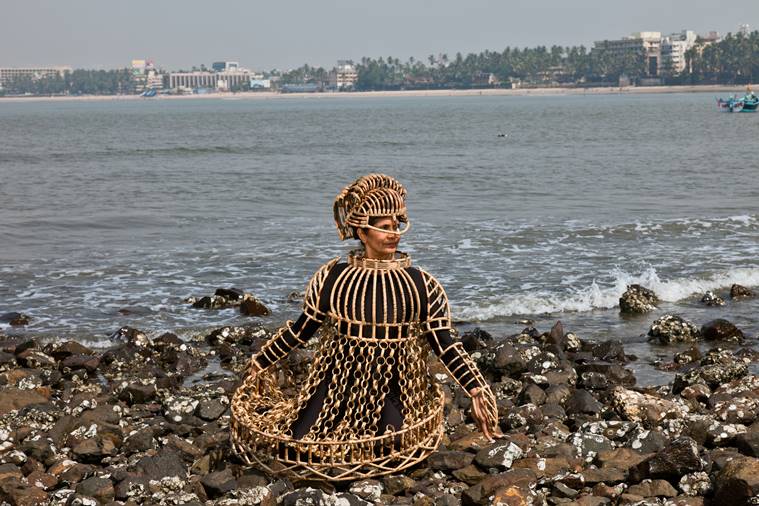 In Venice, she will also present drawings that have her in the armoured sculptures, navigating Mumbai traffic.
In Venice, she will also present drawings that have her in the armoured sculptures, navigating Mumbai traffic.
Shakuntala Kulkarni
Appalled by the insecurities and violence experienced by women in India, artist Shakuntala Kulkarni has been delving into the lives of urban women for over two decades now. One of her most celebrated series, Of Bodies, Armour and Cages (2012), comprises cane armour objects and adornments woven like “disembodied parts”, including masks, cages, shields, headgears and jewellery. Through the work, the Mumbai-based artist plays on the irony of the armour presented as a means of protection that also perhaps acts as an entrapment. “I wanted to explore what happens when you have a costume as protection. At one level, you might feel more secure, but your body is also trapped,” says Kulkarni, 69.
The inspiration for the sculpted designs, on show at the biennale, come from varied sources, Gothic outfits to costumes worn by Kathakali and Manipuri dancers and the bouffant hairstyle popular in the 1970s. “My pieces have no cultural, geographical or religious boundaries,” says Kulkarni. While she initially painted abstracts, she turned to more figurative depictions as she began to address human predicament in her work. Gradually, the focus shifted specifically to patriarchal societal structures and multimedia installations became the medium. If her 2001 installation Reduced Spaces addressed suffocation and constant fear felt by women in India owing to societal constraints, the 2004 video Ajjincya Goshti (Grandmother’s Tales) deliberated on traditional values in a more modernised era.
In Venice, she will also present drawings that have her in the armoured sculptures, navigating Mumbai traffic, including at Shivaji Park, where one day, when she was passing by, hot tar fell on her without warning. “It came out of nowhere and my hair, eyelashes, everything was burning. It made me wonder, how do I protect myself? How do I feel safe when I walk on the road?” says Kulkarni.
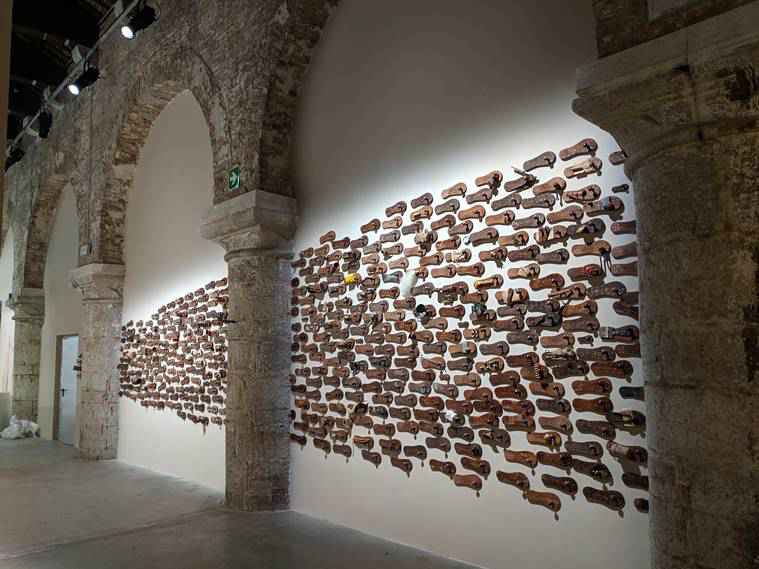 Collected from across India, including Varanasi and Haridwar, Iranna gives a distinct identity to each paduka.
Collected from across India, including Varanasi and Haridwar, Iranna gives a distinct identity to each paduka.
GR Iranna
On a wall at the Arsenale, one of the venues of the biennale, GR Iranna has painstakingly nailed hundreds of padukas or wooden slippers — they form his installation Naavu, that literally means “we together” in Kannada. The Delhi-based artist’s work is symbolic of a group of people going on a march, evoking the Dandi March led by Gandhi in 1930. “Each paduka represents a particular individual with their own personal history. I am bringing these people together to join a movement, just as people came together to protest against the British government. People have the ability to bring about a change if they are united,” says Iranna, 49.
Collected from across India, including Varanasi and Haridwar, Iranna gives a distinct identity to each paduka, using objects such as ghungroos, scissors or painting over them to represent people from diverse backgrounds. “We might belong to different professions and have varied opinions but there are shared values as well,” adds Iranna.
Born into a farming family, the artist recalls how his grandmother would tell him stories of Gandhi when he was a child and he would be fascinated by the leader when he read about him in school. As a student at an ashram in his native village of Sindgi in Karnataka, during his formative years, Iranna came across the paduka on the samadhi (memorial) that students would touch before beginning their lessons. “It is a spiritual object, a symbol of peace and non-violence that is much-required today,” says Iranna, who has used it as a recurring motif in his work.
In Venice, he notes, Naavu, which was first showcased in 2012, acquires new meaning when viewed alongside the Greek pillars in the exhibition space. “Sometimes, we surpass limitations or take steps that we perhaps don’t wish to but are forced to by circumstances,” says Iranna.
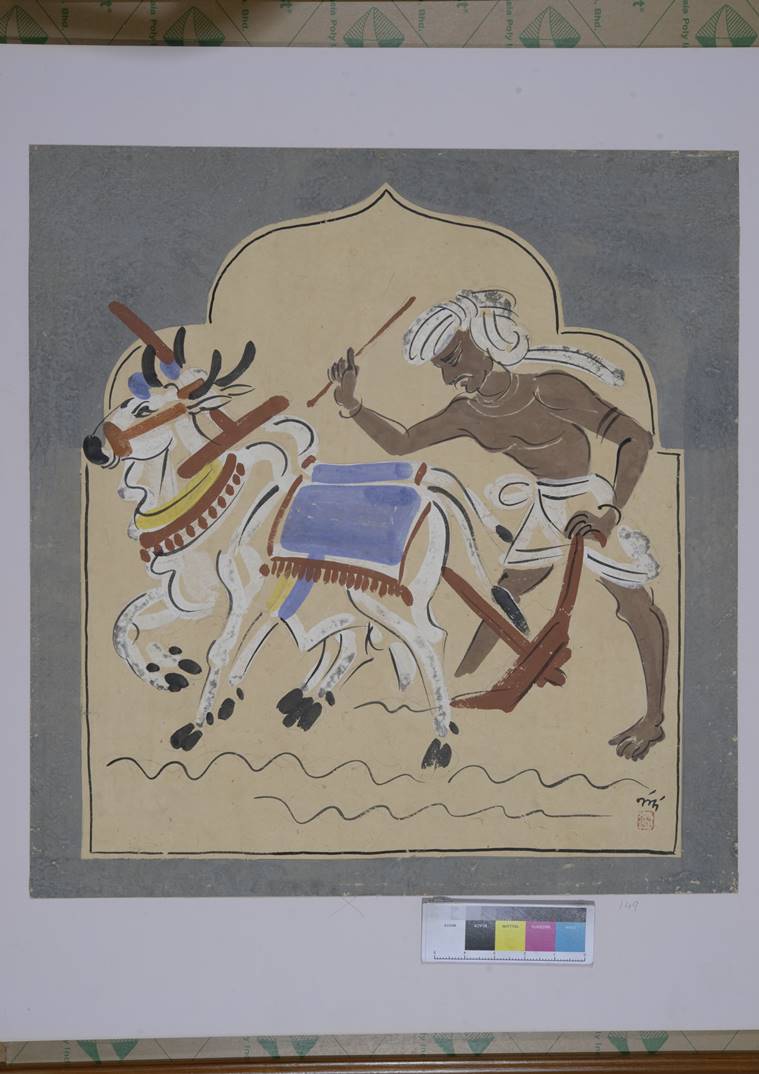 Nandalal Bose’s Haripura Panels
Nandalal Bose’s Haripura Panels
Nandalal Bose (1882-1966)
Nandalal Bose’s Haripura Panels, that were commissioned by Mahatma Gandhi in 1938 for the pandal for the Congress session at Haripura, is part of the collection at the National Gallery of Modern Art. Influenced by folk art and local culture, the panels represent everyday life in India.
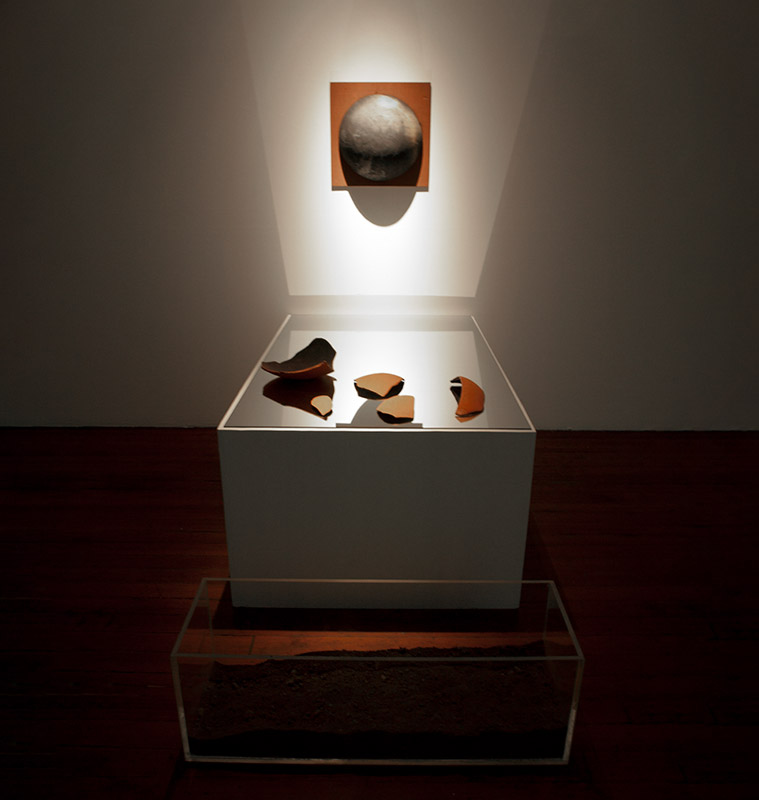 Rummana Hussain’s Fragments (1993) is made up of shards of broken pots.
Rummana Hussain’s Fragments (1993) is made up of shards of broken pots.
Rummana Hussain (1952-1999)
A pioneer of conceptual art in India, Rummana Hussain’s Fragments (1993) is made up of shards of broken pots. A figurative artist, her works took a radical turn after the Babri Masjid demolition, when she began to respond to the politics of the times through her work.
 The image depicts the modernist artist’s idea of a nation.
The image depicts the modernist artist’s idea of a nation.
MF Husain (1915-2011)
Painted in 1955, years after India gained independence, in Zamin, MF Husain represents, among others, Gandhi’s village republics. It depicts the modernist artist’s idea of a nation and his vision of a united India that takes pride in its diversity.
This article appeared in print with the headline ‘Talking of Mohandas’
Apr 19: Latest News
- 01
- 02
- 03
- 04
- 05






































